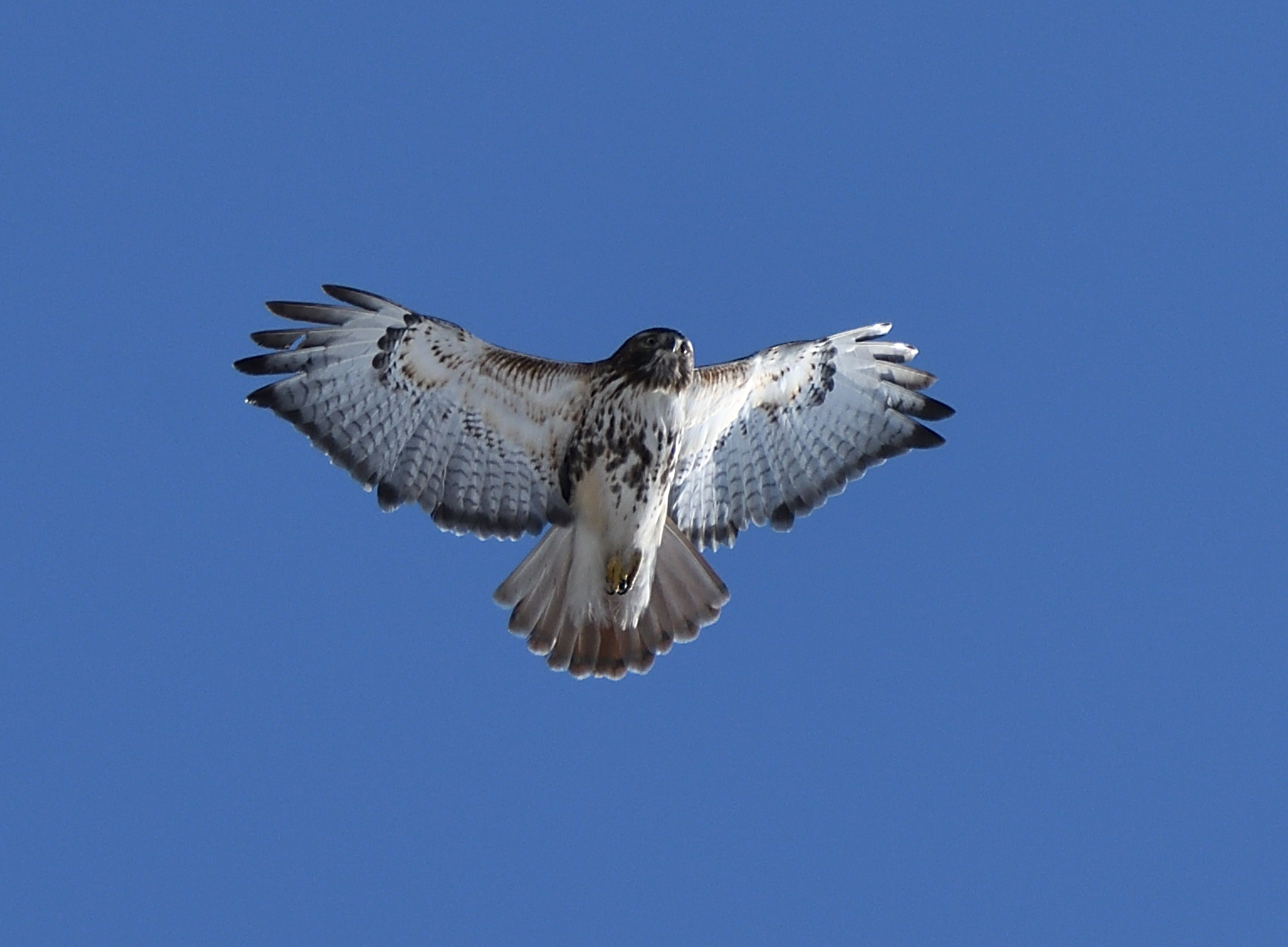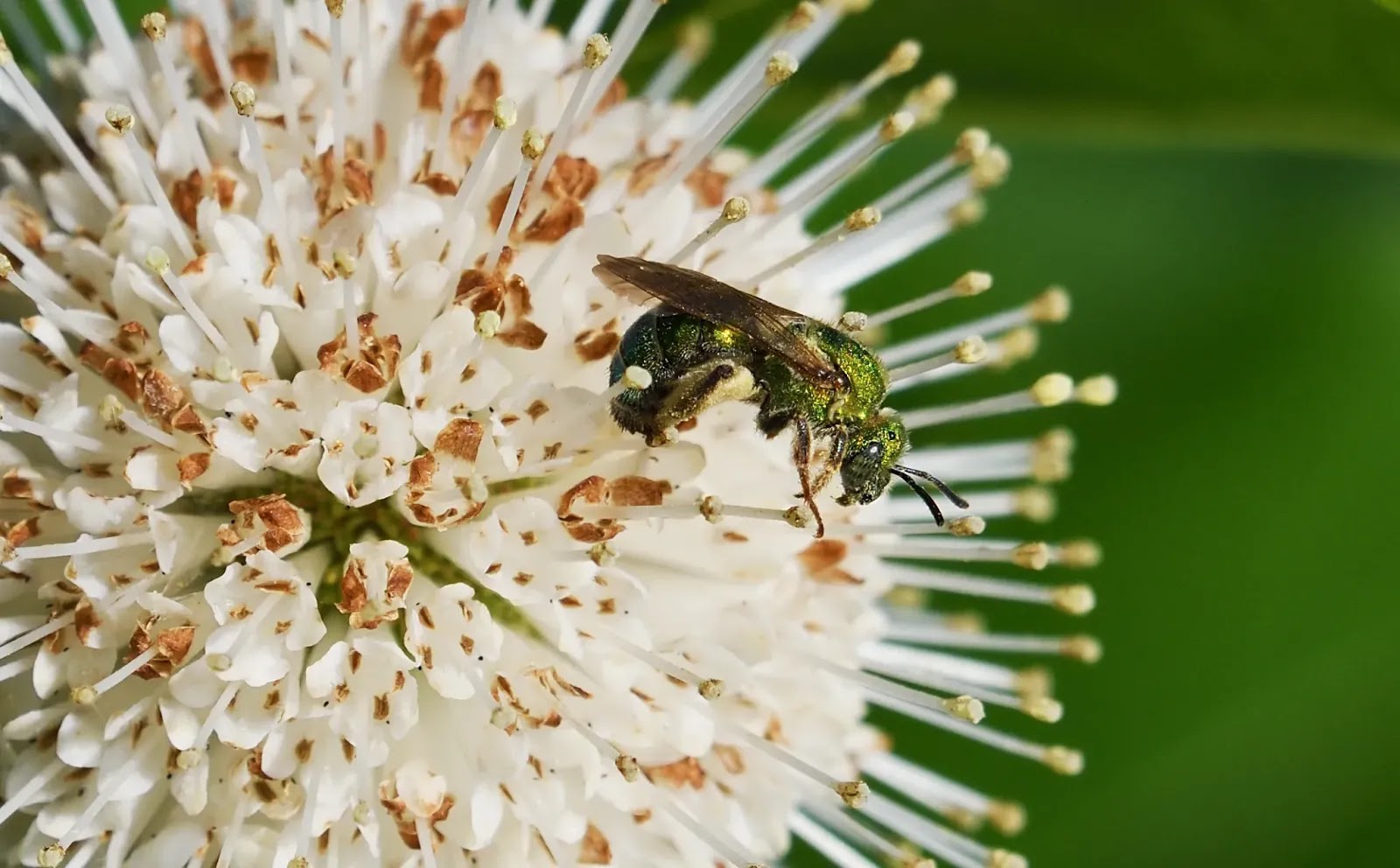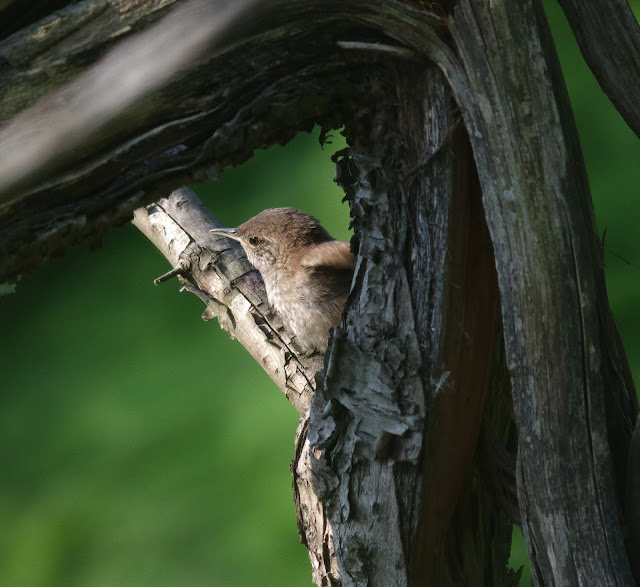Flying High
When you consider the density of wildlife present at Lakeside Park, it is not surprising that the park also attracts lots of predators. Aerial predators are energy conscious and can oftentimes be hard to locate, as they are hidden from sight, watching and waiting for an opportunity that will not be a wasted effort. Sometimes, the lack of activity from the squirrels and birds is a giveaway; other times it is the overactivity, the noisy complaints targetted at the predator that gives away its location. It was the cawing of crows that made me look up as they mobbed this red-tailed hawk, forcing it to circle up and away from the park.
Hearing, I find at times to be much more useful than sight when it comes to birdwatching. I know; it does seem to be a contradiction, but I was led to my next predator by listening to the complaints of chickadees.
I was fortunate that the bright morning sunlight lit up the chest feathers of this Cooper's hawk, making it fairly easy to locate amongst the shaded branches and the deep blue sky in the background.
Watching and waiting; that is the plan. It's just a matter of time before the perfect opportunity presents itself.
Or until a family of chickadees tells everyone in the local vicinity where you are.
The only option then is to move on to a new area, and that was indeed the intention of the chickadees.
I played cat and mouse with the Cooper's hawk for a while using the local birds as my GPS until the hawk moved away from the lake. So, what were the hawks looking to prey on? Pretty much anything small enough for them to handle from grey squirrels all the way down to small rodents and birds like the chickadees.
Squirrels are plentiful at Lakeside Park, and perhaps that has something to do with all the black walnut trees around the lake.
Doves are also on the prey list for the hawks, and there have been so many mourning doves at Lakeside Park recently.
A fairly common bird, but nonetheless really beautiful.
Woodpeckers are as much at home in the trees as the squirrels. I was lucky enough, after lots of waiting, to capture a few good photos of a red-bellied woodpecker in the trees beside the turtle nesting area.
The hairy woodpeckers displayed a head-back posture before chasing each other, darting left and right on the tree trunks.
And here is a female British house sparrow enjoying a bath amid a jumble of rocks and twigs, in what has to be the only accessible running water at Lakeside Park right now. The water comes from a drainage pipe under the walkway and never seems to completely freeze.
Copyright © wildlakeside.blogspot.com 2020 Scott Atkinson All Rights Reserved.
Hearing, I find at times to be much more useful than sight when it comes to birdwatching. I know; it does seem to be a contradiction, but I was led to my next predator by listening to the complaints of chickadees.
I was fortunate that the bright morning sunlight lit up the chest feathers of this Cooper's hawk, making it fairly easy to locate amongst the shaded branches and the deep blue sky in the background.
Watching and waiting; that is the plan. It's just a matter of time before the perfect opportunity presents itself.
Or until a family of chickadees tells everyone in the local vicinity where you are.
The only option then is to move on to a new area, and that was indeed the intention of the chickadees.
I played cat and mouse with the Cooper's hawk for a while using the local birds as my GPS until the hawk moved away from the lake. So, what were the hawks looking to prey on? Pretty much anything small enough for them to handle from grey squirrels all the way down to small rodents and birds like the chickadees.
Squirrels are plentiful at Lakeside Park, and perhaps that has something to do with all the black walnut trees around the lake.
Doves are also on the prey list for the hawks, and there have been so many mourning doves at Lakeside Park recently.
A fairly common bird, but nonetheless really beautiful.
Woodpeckers are as much at home in the trees as the squirrels. I was lucky enough, after lots of waiting, to capture a few good photos of a red-bellied woodpecker in the trees beside the turtle nesting area.
The trees are like a winter food storage facility for the woodpeckers, and they search every crack and crevice right side up or upside down.
Not to be outdone by the red-bellied woodpecker; here is a white-breasted nuthatch right side up.
And upside down. This photo really shows how the white-breasted nuthatch uses its claws to grip onto the bark of the tree.
There has been a lot of activity with the hairy and downy woodpeckers starting to show courtship display. I followed this pair of hairy woodpeckers from one end of the lake to the other.
The hairy woodpeckers displayed a head-back posture before chasing each other, darting left and right on the tree trunks.
One more photo of a hairy woodpecker with a little better detail.
I cannot leave this post without adding a couple of photos I took of a white-throated sparrow at the top edge of the lake.
I am not sure that a sparrow should be so brilliantly coloured.
I am more used to the subtle shades of the British house sparrow pictured here, also at Lakeside Park.
And here is a female British house sparrow enjoying a bath amid a jumble of rocks and twigs, in what has to be the only accessible running water at Lakeside Park right now. The water comes from a drainage pipe under the walkway and never seems to completely freeze.
As you can imagine, in a frozen Lakeside Park this running water is like an oasis for the birds. Here is a dark-eyed junco also enjoying this location.
The cute award for this post goes to this photo. A really dark and grainy image, taken from too far away for any detail, but it is the first chipmunk I have seen this year and I do like how it appeared out of its little hobbit-hole.
My final photo for this day at Lakeside Park this February and it is my favourite, not because it has rare subject matter or that it shows remarkable detail, as it doesn't. It is a squirrel with the sun behind it on a tree stump surrounded by cattails that are blurred in the foreground. The white of the frozen lake is just showing through the now broken and bent reeds that once stood straight, and the blurred trees on the far bank make the background. I just love this photo.
Copyright © wildlakeside.blogspot.com 2020 Scott Atkinson All Rights Reserved.


























Comments
Post a Comment